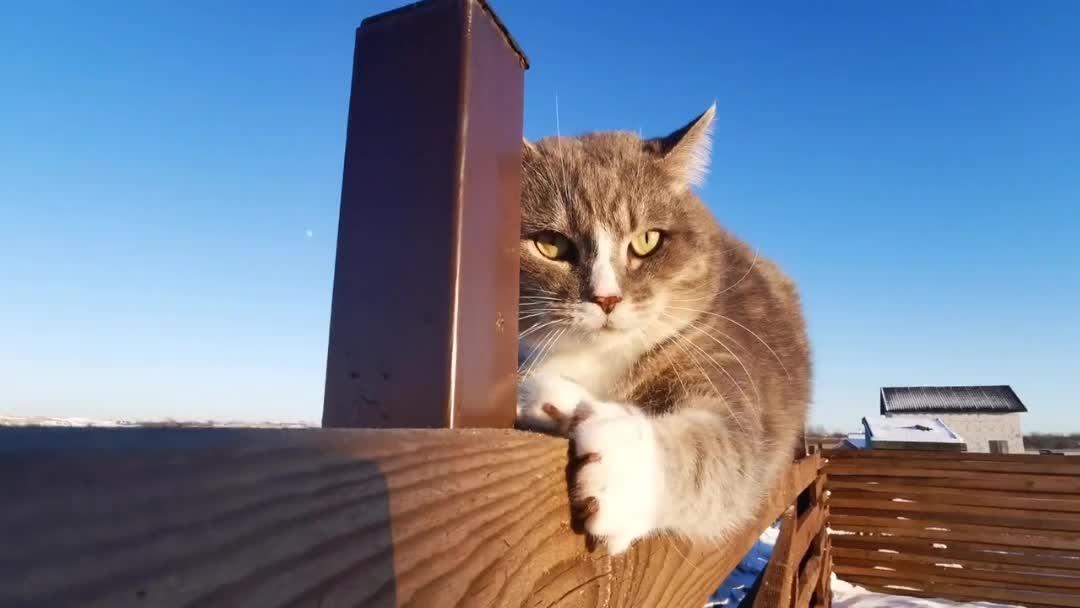Premium Only Content

When cats are focus on some things and very cunning.
It is a big, strong cat, similar to the Maine Coon breed, with long legs, a bushy tail, and a sturdy body. It is very good at climbing, partly because of strong claws. The lifespan is usually 14 to 16 years. Kidney and heart diseases have been reported in the breed. Specifically in this breed, complex rearrangements of glycogen branching enzyme (GBE1) can cause a perinatal hypoglycaemic collapse and a late-juvenile-onset neuromuscular degeneration in glycogen storage disease type IV.[citation needed]
Eighteen-month-old Norwegian Forest cat.
History
Edit
The Norwegian Forest cat is adapted to survive Norway's cold weather.[2][3] Its ancestors may include cold-adapted black and white British shorthair cats brought to Norway from Great Britain some time after 1000 AD by the Vikings, and longhaired cats brought to Norway by Crusaders c.14th century. These cats could have reproduced with farm and feral stock and may have eventually evolved into the modern-day Norwegian Forest breed.[4][5][6] The Siberian and the Turkish Angora, longhaired cats from Russia and Turkey, respectively, are also possible ancestors of the breed.[4] Norse legends refer to the skogkatt as a "mountain-dwelling fairy cat with an ability to climb sheer rock faces that other cats could not manage."[7] Since the Norwegian Forest cat is a very adept climber,[8][9] author Claire Bessant believes that the skogkatt folktale could be about the ancestor of the modern Norwegian Forest breed.[7] The name Norse skogkatt is used by some breeders and fancier organisations for the modern breed.
Most likely the ancestors of the Norwegian Forest cat served as ships' cats (mousers) on Viking ships.[10] The original landrace lived in the Norwegian forests for many centuries, but were later prized for their hunting skills and were used on Norwegian farms,[11] until they were discovered in the early twentieth century by cat enthusiasts.[12]
In 1938 the first organisation devoted to the breed, the Norwegian Forest Cat Club, was formed in Oslo, Norway.[13] The club's movement to preserve the breed was interrupted by World War II. Owing to cross-breeding with free-ranging domestic cats during the war, the Norwegian Forest cat became endangered and nearly extinct until the Norwegian Forest Cat Club helped the breed make a comeback by developing an official breeding program.[14][15] In the 1950s, King Olav V declared them the official cat of Norway.[16] Since the cat did not leave Norway until the 1970s, it was not registered as a breed in the Fédération Internationale Féline (FIFe), the pan-European federation of cat registries, until Carl-Fredrik Nordane, a Norwegian cat fancier, took notice of the breed, and made efforts to register it.[13] The breed was registered in Europe by the 1970s, and in the American Cat Fanciers Association in 1994.[17] In 1978, it was recognized in Sweden as an official breed,[18] and in 1989, they were accepted as a breed in the United Kingdom by the Norwegian Cat Club of Britain.[19]
The Norwegian Forest breed is very popular in Norway and Sweden. Since 2003, it has been the fifth most popular cat breed in France, where there are about 400 to 500 births per year.
-
 LIVE
LIVE
The White House
2 hours agoAbove, Below & Beyond: A Presidential Special
809 watching -
 LIVE
LIVE
Flyover Conservatives
9 hours agoTough Love for Trump: What Must Change Now to Win Back America - Dennis Michael Lynch | FOC Show
285 watching -
 LIVE
LIVE
Sarah Westall
1 hour agoYounger Human Brains are Vastly Different than Older Generations w/ Neurologist Dr Jack McCallum
219 watching -
 LIVE
LIVE
megimu32
59 minutes agoON THE SUBJECT: The Movies That Made Millennials — And the Ones That Missed 🎥
178 watching -
 LIVE
LIVE
Anthony Rogers
1 day agoEpisode 389 - Tommy Gunn
26 watching -
 18:13
18:13
T-SPLY
3 hours agoChicago Mayor Accuses ICE Of Human Rights Violations!
4.11K11 -
 1:09:47
1:09:47
iCkEdMeL
2 hours ago $2.16 earned🔴 Redwood City Standoff Erupts in Gunfire | Police Shooting Update
19.9K2 -
 13:10:31
13:10:31
LFA TV
23 hours agoLIVE & BREAKING NEWS! | TUESDAY 11/11/25
180K34 -
 30:53
30:53
BonginoReport
8 hours agoMonica Kelsey: The Woman Who Is Saving Countless Babies - Nightly Scroll w/ Hayley Caronia (Ep.175)
104K17 -
 1:08:36
1:08:36
Kim Iversen
6 hours agoFrom Head Chopping to The Oval Office: Who is Al-Sharaa?
96.6K78